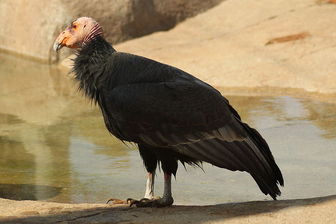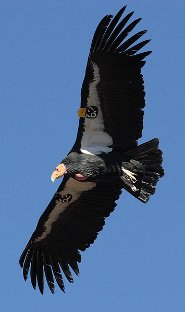California condor
Species-level:

Original source: california condorUploaded by Snowmanradio
Author: Stacy from San Diego
California Condor - Wearing its Heart on its Sleeve
 The California condor (Gymnogyps californianus) is among the largest of the world's flying birds. They will fly as far as 150 miles a day in search of food. These birds have a lifespan of up to 60 years, making it one of the longest-living birds ever. They are often found near large, tall trees or cliffs, where they can build their nests.
The California condor (Gymnogyps californianus) is among the largest of the world's flying birds. They will fly as far as 150 miles a day in search of food. These birds have a lifespan of up to 60 years, making it one of the longest-living birds ever. They are often found near large, tall trees or cliffs, where they can build their nests.
These distinctive vultures have very long necks and bald heads, allowing them to feed within a carcass. Bodily fluids will not get stuck to them due to the way they are built. When they need to keep warm, they can tuck their heads into their fluffy, feathery collars. Amazingly, the skin color of these birds change depending on their emotions. The colors can vary from yellow to a neon-green to a glowing red-orange, to even a purplish-blue.
California condors scavenge for food and will often remain high in the air, circling around a newly found meal to signal to other condors that it is time to eat. They feed primarily on carrion, and will search for miles to find it. Besides human beings (via hunting), the condors major predators include eagles, coyotes, snakes and mountain lions. These animals primarily attack young condors or eat condor eggs
The average weight of the California condor is 8 to 13 kilograms (18 to 29 pounds). Their wingspan can be nearly 3 meters wide, or 9.5 feet, the largest wingspan of any other bird in North America. These birds mate for life and lay one egg every two years.
The California condor resides in the mountains of south-central California, the Grand Canyon and Zion National Park. California condors are on the critically endangered list. There are only about 400 of these birds left on the planet, including the nearly 200 that are in the wild. When they became extinct in the wild, a captive breeding program began to keep them alive. The condor chicks who are born into captivity are fed with a condor hand puppet, making sure they don't become to attacked to their human caretakers.
The California condor is classified as Critically Endangered (CR), facing an extremely high risk of extinction in the wild.

Family : Cathartidae
Genus : Gymnogyps
Species : californianus
Authority : (Shaw, 1898)
